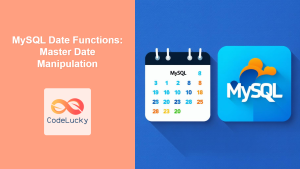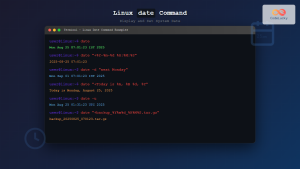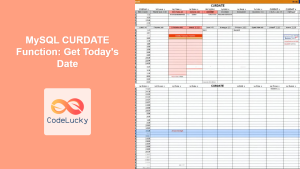In the world of databases, handling date and time data is a crucial skill for any SQL developer. Whether you're tracking customer orders, managing employee schedules, or analyzing time-series data, mastering SQL date functions is essential. This comprehensive guide will dive deep into the various date and time functions available in SQL, providing you with the tools you need to manipulate temporal data effectively.
Understanding Date and Time Data Types
Before we delve into specific functions, it's important to understand the common date and time data types in SQL:
DATE: Stores date values (YYYY-MM-DD)TIME: Stores time values (HH:MM:SS)DATETIMEorTIMESTAMP: Stores both date and time values (YYYY-MM-DD HH:MM:SS)
Different database management systems may have slight variations in these data types, but the concepts remain similar.
Retrieving Current Date and Time
One of the most basic operations is retrieving the current date and time. Let's look at some common functions:
GETDATE() (SQL Server)
SELECT GETDATE() AS CurrentDateTime;
Result:
CurrentDateTime
---------------------
2023-06-15 14:30:45
CURRENT_TIMESTAMP (Standard SQL)
SELECT CURRENT_TIMESTAMP AS CurrentDateTime;
Result:
CurrentDateTime
---------------------
2023-06-15 14:30:45
SYSDATE (Oracle)
SELECT SYSDATE AS CurrentDateTime FROM DUAL;
Result:
CurrentDateTime
---------------------
15-JUN-23 14:30:45
🕒 These functions are incredibly useful for logging timestamps, setting default values for date columns, or calculating time differences.
Extracting Parts of a Date
Often, you'll need to extract specific parts of a date, such as the year, month, or day. SQL provides several functions for this purpose.
YEAR(), MONTH(), DAY() (SQL Server, MySQL)
DECLARE @SampleDate DATE = '2023-06-15';
SELECT
YEAR(@SampleDate) AS YearPart,
MONTH(@SampleDate) AS MonthPart,
DAY(@SampleDate) AS DayPart;
Result:
YearPart MonthPart DayPart
--------- --------- -------
2023 6 15
EXTRACT() (Standard SQL, PostgreSQL, Oracle)
SELECT
EXTRACT(YEAR FROM DATE '2023-06-15') AS YearPart,
EXTRACT(MONTH FROM DATE '2023-06-15') AS MonthPart,
EXTRACT(DAY FROM DATE '2023-06-15') AS DayPart;
Result:
YearPart MonthPart DayPart
--------- --------- -------
2023 6 15
🗓️ These functions are particularly useful when you need to group data by year, month, or day, or when you want to filter records based on specific date components.
Date Arithmetic
Performing calculations with dates is a common requirement in many applications. Let's explore some ways to add or subtract time from dates.
DATEADD() (SQL Server)
DECLARE @StartDate DATE = '2023-06-15';
SELECT
DATEADD(DAY, 7, @StartDate) AS OneWeekLater,
DATEADD(MONTH, 1, @StartDate) AS OneMonthLater,
DATEADD(YEAR, -1, @StartDate) AS OneYearEarlier;
Result:
OneWeekLater OneMonthLater OneYearEarlier
------------- ------------- ---------------
2023-06-22 2023-07-15 2022-06-15
DATE_ADD() (MySQL)
SELECT
DATE_ADD('2023-06-15', INTERVAL 7 DAY) AS OneWeekLater,
DATE_ADD('2023-06-15', INTERVAL 1 MONTH) AS OneMonthLater,
DATE_ADD('2023-06-15', INTERVAL -1 YEAR) AS OneYearEarlier;
Result:
OneWeekLater OneMonthLater OneYearEarlier
------------- ------------- ---------------
2023-06-22 2023-07-15 2022-06-15
⏰ These functions are invaluable when you need to calculate due dates, expiration dates, or any other date-based deadlines in your applications.
Calculating Date Differences
Another common operation is finding the difference between two dates. Let's look at how to do this in different SQL flavors.
DATEDIFF() (SQL Server)
DECLARE @StartDate DATE = '2023-01-01';
DECLARE @EndDate DATE = '2023-06-15';
SELECT
DATEDIFF(DAY, @StartDate, @EndDate) AS DaysDifference,
DATEDIFF(MONTH, @StartDate, @EndDate) AS MonthsDifference,
DATEDIFF(YEAR, @StartDate, @EndDate) AS YearsDifference;
Result:
DaysDifference MonthsDifference YearsDifference
--------------- ----------------- ----------------
165 5 0
TIMESTAMPDIFF() (MySQL)
SELECT
TIMESTAMPDIFF(DAY, '2023-01-01', '2023-06-15') AS DaysDifference,
TIMESTAMPDIFF(MONTH, '2023-01-01', '2023-06-15') AS MonthsDifference,
TIMESTAMPDIFF(YEAR, '2023-01-01', '2023-06-15') AS YearsDifference;
Result:
DaysDifference MonthsDifference YearsDifference
--------------- ----------------- ----------------
165 5 0
📅 These functions are crucial for calculating ages, durations, or any time-based metrics in your database applications.
Formatting Dates
Sometimes, you need to present dates in a specific format. Most SQL databases provide functions to convert dates into formatted strings.
CONVERT() (SQL Server)
DECLARE @SampleDate DATETIME = '2023-06-15 14:30:45';
SELECT
CONVERT(VARCHAR, @SampleDate, 101) AS USFormat,
CONVERT(VARCHAR, @SampleDate, 103) AS BritishFormat,
CONVERT(VARCHAR, @SampleDate, 120) AS ISO8601Format;
Result:
USFormat BritishFormat ISO8601Format
-------------- -------------- -------------------
06/15/2023 15/06/2023 2023-06-15 14:30:45
DATE_FORMAT() (MySQL)
SELECT
DATE_FORMAT('2023-06-15 14:30:45', '%m/%d/%Y') AS USFormat,
DATE_FORMAT('2023-06-15 14:30:45', '%d/%m/%Y') AS BritishFormat,
DATE_FORMAT('2023-06-15 14:30:45', '%Y-%m-%d %H:%i:%s') AS ISO8601Format;
Result:
USFormat BritishFormat ISO8601Format
-------------- -------------- -------------------
06/15/2023 15/06/2023 2023-06-15 14:30:45
🖨️ These formatting functions are essential when you need to display dates in a specific format for reports, user interfaces, or data exports.
Working with Time Zones
In our globalized world, dealing with different time zones is often necessary. Let's look at some functions that help with time zone conversions.
AT TIME ZONE (SQL Server)
DECLARE @UTCTime DATETIMEOFFSET = '2023-06-15 14:30:45 +00:00';
SELECT
@UTCTime AS UTCTime,
@UTCTime AT TIME ZONE 'Pacific Standard Time' AS PacificTime,
@UTCTime AT TIME ZONE 'Central European Standard Time' AS CentralEuropeanTime;
Result:
UTCTime PacificTime CentralEuropeanTime
-------------------------- -------------------------- --------------------------
2023-06-15 14:30:45 +00:00 2023-06-15 07:30:45 -07:00 2023-06-15 16:30:45 +02:00
CONVERT_TZ() (MySQL)
SELECT
'2023-06-15 14:30:45' AS UTCTime,
CONVERT_TZ('2023-06-15 14:30:45', '+00:00', '-07:00') AS PacificTime,
CONVERT_TZ('2023-06-15 14:30:45', '+00:00', '+02:00') AS CentralEuropeanTime;
Result:
UTCTime PacificTime CentralEuropeanTime
------------------- ------------------- ---------------------
2023-06-15 14:30:45 2023-06-15 07:30:45 2023-06-15 16:30:45
🌍 These time zone functions are crucial for applications that need to handle data from different geographical locations or display times in users' local time zones.
Practical Examples
Let's look at some practical examples that combine multiple date functions to solve real-world problems.
Example 1: Calculating Age
Suppose we have a table of employees and we want to calculate their age based on their birth date.
CREATE TABLE Employees (
EmployeeID INT PRIMARY KEY,
FirstName VARCHAR(50),
LastName VARCHAR(50),
BirthDate DATE
);
INSERT INTO Employees (EmployeeID, FirstName, LastName, BirthDate)
VALUES
(1, 'John', 'Doe', '1990-05-15'),
(2, 'Jane', 'Smith', '1985-08-20'),
(3, 'Mike', 'Johnson', '1992-11-30');
SELECT
EmployeeID,
FirstName,
LastName,
BirthDate,
DATEDIFF(YEAR, BirthDate, GETDATE()) -
CASE
WHEN (MONTH(BirthDate) > MONTH(GETDATE())) OR
(MONTH(BirthDate) = MONTH(GETDATE()) AND DAY(BirthDate) > DAY(GETDATE()))
THEN 1
ELSE 0
END AS Age
FROM Employees;
Result:
EmployeeID FirstName LastName BirthDate Age
---------- --------- -------- ----------- ---
1 John Doe 1990-05-15 33
2 Jane Smith 1985-08-20 37
3 Mike Johnson 1992-11-30 30
This query calculates the age accurately by subtracting a year if the birthday hasn't occurred yet this year.
Example 2: Finding Overdue Tasks
Let's say we have a task management system and we want to find all tasks that are overdue.
CREATE TABLE Tasks (
TaskID INT PRIMARY KEY,
TaskName VARCHAR(100),
AssignedDate DATE,
DueDate DATE,
CompletedDate DATE NULL
);
INSERT INTO Tasks (TaskID, TaskName, AssignedDate, DueDate, CompletedDate)
VALUES
(1, 'Complete Project Proposal', '2023-05-01', '2023-05-15', '2023-05-14'),
(2, 'Review Client Feedback', '2023-05-10', '2023-05-20', NULL),
(3, 'Prepare Quarterly Report', '2023-06-01', '2023-06-10', NULL);
SELECT
TaskID,
TaskName,
AssignedDate,
DueDate,
DATEDIFF(DAY, DueDate, GETDATE()) AS DaysOverdue
FROM Tasks
WHERE CompletedDate IS NULL AND DueDate < GETDATE()
ORDER BY DaysOverdue DESC;
Result (assuming today is 2023-06-15):
TaskID TaskName AssignedDate DueDate DaysOverdue
------ ----------------------- ------------ ---------- -----------
2 Review Client Feedback 2023-05-10 2023-05-20 26
3 Prepare Quarterly Report 2023-06-01 2023-06-10 5
This query finds all incomplete tasks where the due date has passed and calculates how many days they are overdue.
Conclusion
Mastering SQL date functions is crucial for effective database management and data analysis. From simple operations like retrieving the current date to complex calculations involving time zones and date arithmetic, these functions provide powerful tools for working with temporal data.
Remember that while the concepts are similar across different database systems, the exact syntax may vary. Always consult your specific database's documentation for the most accurate information.
By leveraging these date functions, you can solve a wide range of time-related problems in your database applications, from tracking project deadlines to analyzing historical trends. Practice using these functions in your own projects to become proficient in handling date and time data in SQL.
🚀 Happy coding, and may your queries always return on time!



















